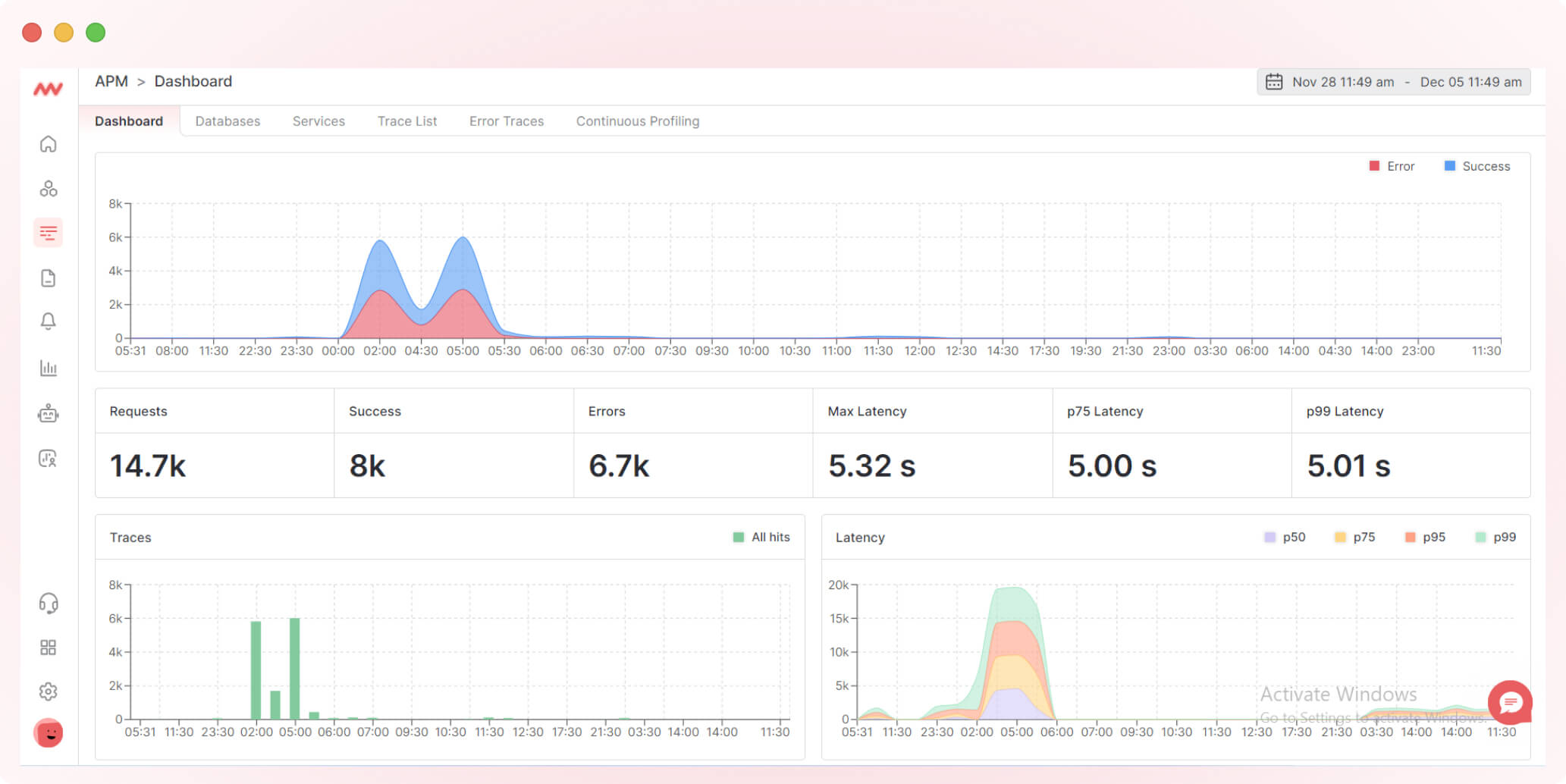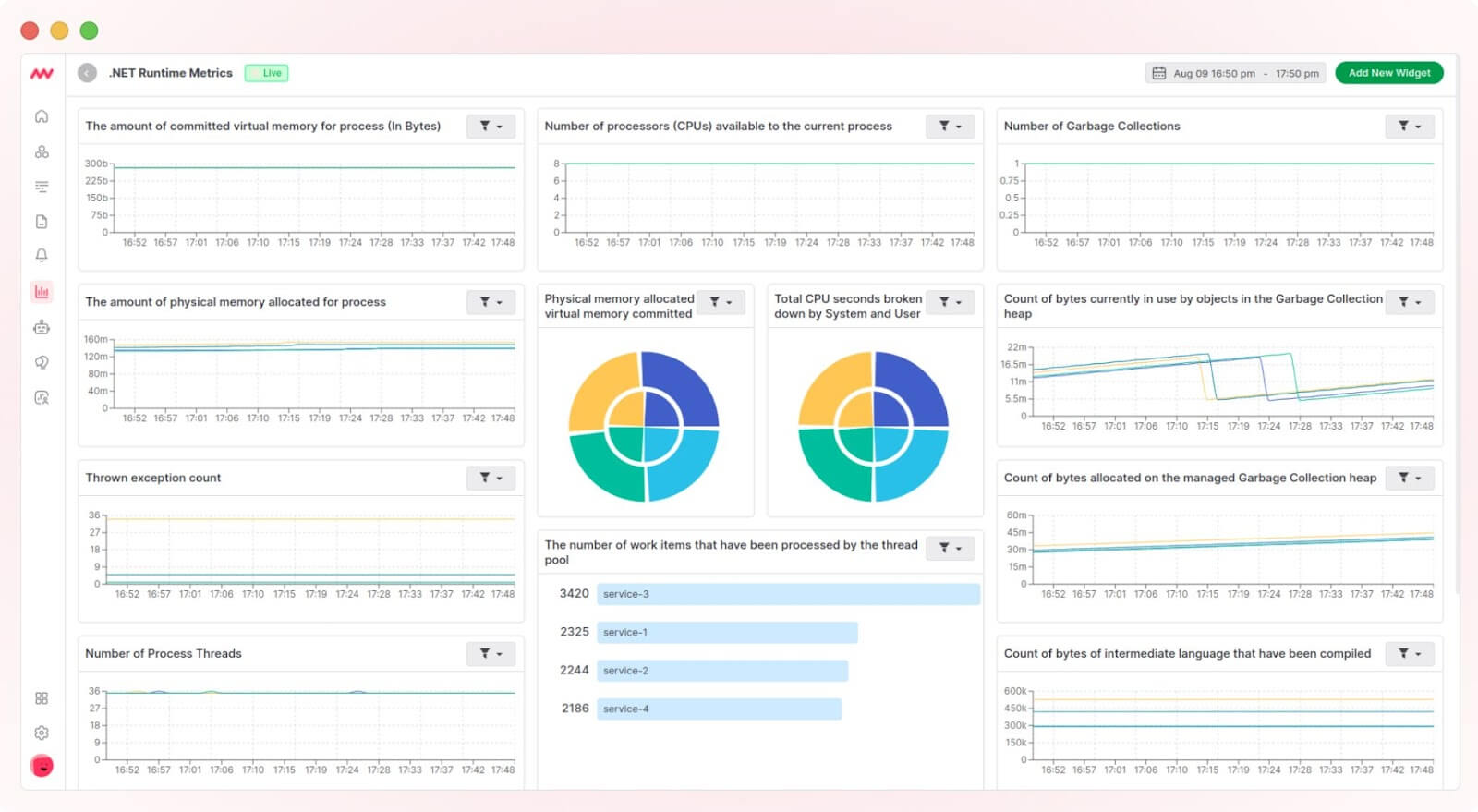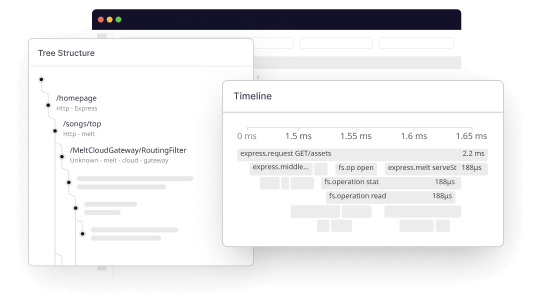Businesses are under constant pressure to deliver high-performing applications. User expectations are soaring, and the consequences of application downtime or poor performance can be severe.
For context, the average cost of downtime across industries is $9,000 per minute, with 98% companies claiming that one hour of downtime costs roughly $100,000.
When an app goes down, IT operations managers, DevOps engineers, SREs, and security teams are under immense pressure to quickly identify the problem and resolve it while implementing preventive measures to mitigate business impact and ensure future reliability.
The whole process is extremely complicated as it requires everyone involved to take quick decisions, collaborate across diverse teams while managing technical, operational, and customer-related issues.
Application Performance Monitoring (APM) solves this challenge, offering real-time insights into application behavior and performance.
This article dives deep into the need for application performance monitoring and offers a guide on how to get it right.
What is Application Performance Monitoring?
Application Performance Monitoring or APM is a process or a collection of tools that helps IT teams ensure optimal application performance, reliability, accessibility and user experience (UX).
APM tools are designed to continuously track a range of metrics and key performance indicators (KPIs) like response time, latency, resource utilization, and error rates in real-time.
Based on this data, it empowers engineers with insights on how applications function, visibility into application components, dependencies, and transactions, and helps identify and diagnose issues.
Furthermore, APM supports performance optimization by pinpointing bottlenecks, optimizing applications, enhancing scalability, and improving the overall UX.

For more details, check out our guide on APM.
Why Monitoring Your Application is Important?
Imagine your favorite e-commerce website throwing a major sale, something like a Black Friday, perhaps?
Shoppers flock to the site, adding products to their carts and initiating transactions. The website’s servers are overwhelmed by traffic, causing the database to struggle. Without effective application performance monitoring, your team might remain oblivious to these issues until it’s too late.
As a result, the website could crash, transactions may fail, and frustrated customers would leave their shopping carts. In this scenario, the absence of proper APM practices can turn any Black Friday blue.
APM is important as it helps businesses identify and address performance issues, ensuring a good user experience, operational efficiency, and overall business success.
Faster Issue Detection and Resolution
Faster issue detection and resolution is an essential aspect of APM, helping engineers proactively identify and address performance issues.
Here are some of the benefits:
- Minimizing Downtime: APM enables businesses to detect and resolve real-time issues, reducing downtime and preventing potential revenue loss.
- Enhanced User Experience: Rapid issue resolution improves user experience, reducing frustration and enhancing brand loyalty.
- Operational Efficiency: Quick problem-solving reduces operational costs tied to extended downtimes and extensive troubleshooting efforts.
- Brand Protection: A proactive approach to resolving issues safeguards your brand’s reputation, demonstrating reliability and commitment to quality.
- Competitive Advantage: Organizations excelling in issue resolution gain a competitive edge, attracting and retaining users.
Improved Real-time Monitoring
Improved real-time monitoring allows organizations to comprehensively view an application’s performance the moment it occurs. To detect real-time issues, organizations can use APM tools that constantly monitor performance metrics and set up immediate alerts.
For example, a website can use real-time monitoring to detect a sudden spike in page load times, allowing the IT team to promptly investigate and rectify the issue.
- Real-time Issue Identification: With real-time insights, APM tools can promptly detect performance anomalies, allowing organizations to take swift action to resolve issues.
- Proactive Performance Optimization: Real-time monitoring provides a continuous stream of data, enabling organizations to make immediate adjustments to maintain optimal application performance.
- Resource Allocation: Real-time data helps optimize resource allocation by reallocating resources where needed based on current performance metrics.
Address ERP Issues
Addressing Enterprise Resource Planning (ERP) involves identifying and resolving errors, bugs, or vulnerabilities within the ERP systems that are critical for business operations.
Imagine a logistics company that relies on ERP systems for route optimization. If an issue within the ERP system leads to inaccurate route calculations, it can result in delays, extra fuel consumption, and operational inefficiencies.
APM tools can continuously monitor the ERP system’s performance, and if it detects anomalies, such as a sudden increase in route planning times, it triggers alerts. This allows the logistics company to promptly investigate and resolve the ERP issue, reducing costs and ensuring their operations remain efficient.
Addressing ERP issues within the APM framework offers several advantages:
- Business Continuity: Quickly resolving ERP issues ensures that core business processes remain operational, avoiding disruptions.
- Data Integrity: Maintaining data integrity within ERP systems is crucial for accurate decision-making, and addressing issues promptly prevents data corruption.
- Operational Efficiency: ERP issues can impact various facets of business operations. Resolving them proactively ensures that resources and time are well-spent.
- Compliance and Reporting: In regulated industries, addressing ERP issues ensures compliance and reporting.
Improve Application Performance
Improving application performance involves optimizing various aspects of an application to enhance its responsiveness, speed, and efficiency.
Consider a mobile app for a ride-sharing service. If APM tools detect that ride requests are taking longer to process or that the app frequently freezes during navigation, alerts are triggered.
This prompts the DevOps team to investigate and optimize the application’s performance. As a result, the ride-sharing service offers a more efficient and enjoyable user experience, ultimately attracting and retaining more users.
- User Satisfaction: A responsive and fast application ensures a positive user experience, reducing frustration and improving user satisfaction.
- Efficiency: Optimized application performance leads to more efficient resource usage, reducing operational costs and enhancing resource allocation.
- Competitive Edge: Applications that perform exceptionally well gain a competitive advantage, attracting and retaining users in a crowded digital landscape.
- Data Analysis: APM provides insights into performance bottlenecks, allowing organizations to make data-driven optimizations that improve performance.
Enhanced Security
APM enhances the overall security posture of applications and safeguards sensitive data, ultimately mitigating the risks associated with cyberattacks and breaches.
Imagine an online payment gateway used by numerous e-commerce websites. APM tools monitor transaction data and can detect anomalies, such as unusual transaction patterns or access attempts. Alerts are triggered if a sudden surge in potentially fraudulent transactions is detected.
- Protection of Sensitive Data: Enhanced security within APM helps identify and proactively address vulnerabilities, protecting sensitive customer data and critical business information.
- Regulatory Compliance: By maintaining a secure application environment, APM ensures compliance with industry standards and government regulations, reducing the risk of legal and financial consequences.
- Data Integrity: APM tools monitor and protect data from tampering and corruption, preserving its integrity and accuracy, which is crucial in applications where data quality is paramount.
Reduced operational costs
Application Performance Monitoring not only bolsters application performance but also offers substantial cost-saving advantages for businesses:
- Resource Optimization: APM provides insights into resource utilization, enabling organizations to identify and address underutilized or overprovisioned resources. This optimization minimizes operational costs by ensuring that resources are allocated efficiently.
- Minimized Downtime: Quick issue detection and resolution by APM tools significantly reduce downtime, preventing revenue losses associated with service interruptions and operational standstills.
- Improved Scalability: APM supports the dynamic allocation of resources based on real-time performance metrics. This scalability ensures businesses pay for resources as needed, reducing unnecessary expenses.
- Preventive Maintenance: APM identifies performance bottlenecks and inefficiencies before they escalate into significant issues. This proactive approach minimizes the need for costly emergency fixes and troubleshooting efforts.
- Enhanced User Experience: A good user experience facilitated by APM translates to higher customer retention and potentially increased revenue. Satisfied users are more likely to engage with and continue using applications.
Enhanced User Experience
It refers to the continuous efforts and strategies to make an application, website, or digital platform more user-friendly, efficient, and engaging.
- Swift Issue Resolution: APM tools promptly detect and address performance issues, ensuring users encounter minimal disruptions, faster response times, and fewer errors.
- Reduced Frustration: Users experience fewer delays and errors, reducing frustration and enhancing their overall satisfaction with the application.
- Consistent Performance: APM maintains consistent application performance, providing users with a reliable and responsive experience, which builds trust and loyalty.
- User Retention: Satisfied users are more likely to stay engaged and continue using the application, contributing to user retention and potentially increasing revenue.
Application Monitoring Best Practices
These practices, founded on efficiency and proactive management, facilitate timely issue resolution, reduced downtime, and an exceptional user experience.
- Clear Objectives: Define precise monitoring goals to track what matters most for your application’s performance and user satisfaction.
- Complete Stack Monitoring: Monitor the entire application stack, from infrastructure to end-user experience, to gain comprehensive insights.
- Real-Time Monitoring: Implement real-time monitoring to detect and address issues promptly, preventing disruptions and user dissatisfaction.
- Cross-Team Collaboration: Encourage collaboration across teams to ensure a holistic approach to monitoring and issue resolution.
- Automation and AI: Leverage automation and AI-driven solutions to streamline monitoring processes and gain data-driven insights, improving efficiency.
- Alert Accuracy: Set accurate alerts to avoid alert fatigue and focus on genuine issues, ensuring effective responses to critical events.
Top 3 APM Tools
There are several excellent tools and vendors available in the market. This section will discuss three top APM tools and vendors known for their robust features, reliability, and industry reputation.
Middleware

Middleware is a monitoring platform that specializes in complex, multi-tiered applications. It tracks the performance of web pages and APIs at various network levels, and you can quickly deploy and scale with any environment like Docker, Kubernetes, and more.
- Visualize application performance and uptime data alongside key business metrics to find issues faster.
- Use a detailed time graph to find which step or endpoint has performance issues.
- View a breakdown of network timing data and response time by location for faster root cause analysis.
Sign up for Middleware, free forever APM tool
Datadog
Datadog offers Synthetic Monitoring, which enables users to create code-free tests that simulate user transactions on applications and monitor key network endpoints across different layers of systems.
- Stay ahead of issues by proactively monitoring your endpoints through API tests.
- Easily capture critical transactions without writing any code using our fully hosted web recorder.
- Ensure secure monitoring of any environment by using your private locations.
New Relic
New Relic is a cloud-based observability platform that offers real-time monitoring of software applications, infrastructure, and customer experiences.
- Detects low-performing entities such as URLs, APIs, and services proactively.
- Collaborate to resolve issues automatically generated from affected tests.
- Leverage alerts and AI to transition from synthetic checks to automatically generated tickets within AIOps.
Last Impressions on APM
As you move forward, implementing APM and refining your strategies, remember that APM is not just about maintaining performance; it’s about safeguarding your brand’s reputation, boosting efficiency, and gaining a competitive edge.
Your next steps involve proactive monitoring and continuous improvement, ensuring your applications consistently meet and exceed user expectations.
Try Middleware, the free APM tool!




